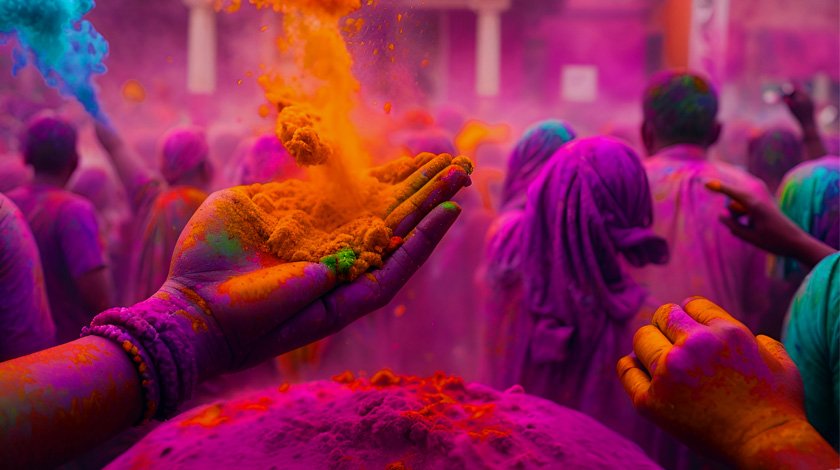- Delhi
- Last Update 02:29: am

What is the Holi Festival and Why is it Celebrated?
Holi, often dubbed the "Festival of Colors," is a jubilant and vibrant celebration observed primarily in India and Nepal, although its popularity has spread to various parts of the world. It usually falls in the month of March, marking the arrival of spring and the triumph of good over evil.
Holi is a festival deeply ingrained in the cultural and religious fabric of Hinduism, but its message of joy and unity transcends religious boundaries, welcoming people of all faiths and backgrounds to partake in its festivities.
At its heart, Holi is a celebration of joy, love, and the renewal of life. Its origins can be traced back to ancient Hindu mythology, where it is associated with various legends and stories. One of the most famous tales associated with Holi is the legend of Holika and Prahlad.
According to Hindu scriptures, there was once a demon king named Hiranyakashipu who had gained immense power through a boon from Lord Brahma, making him virtually indestructible. However, his own son, Prahlad, remained devoted to Lord Vishnu, much to the dismay of his father. Unable to tolerate Prahlad's unwavering faith, Hiranyakashipu conspired with his sister, Holika, who had a magical cloak rendering her immune to fire.
Together, they plotted to kill Prahlad by tricking him into sitting on a pyre with Holika. But as the flames engulfed them, it was Holika who perished, while Prahlad emerged unharmed, protected by his devotion to the divine. This symbolic victory of good over evil is commemorated during Holi with the ritual of lighting bonfires, known as "Holika Dahan" or "Chhoti Holi," on the eve of the main festival day.
The main day of Holi is marked by joyful revelry and merrymaking. People gather in open spaces, streets, and public squares, armed with colored powders and water-filled balloons. The air is filled with laughter, music, and the exuberant cries of "Holi Hai" (It's Holi!).
The highlight of Holi is the playful throwing and smearing of colors on friends, family, and even strangers. People of all ages, genders, and backgrounds come together to participate in this riot of colors, breaking down social barriers and fostering a sense of unity and camaraderie. It's a time when old grudges are forgotten, and new friendships are forged amidst the kaleidoscope of hues.
Traditional Holi sweets and delicacies are an integral part of the festivities, adding to the joyous atmosphere. Gujiya, a sweet dumpling filled with khoya (reduced milk) and dry fruits, and thandai, a chilled milk beverage infused with nuts, spices, and sometimes bhang (cannabis extract), are commonly enjoyed during Holi. These treats symbolize the spirit of sharing and indulgence that permeates the festival.
Music and dance play a significant role in Holi celebrations, with people dancing to the rhythm of traditional folk songs and Bollywood tunes. The streets come alive with the sound of drums, flutes, and other musical instruments, creating a festive atmosphere that is infectious to all who partake in it.
While Holi is deeply rooted in Hindu culture and mythology, its message of love, unity, and forgiveness resonates with people of all faiths and backgrounds. In recent years, Holi has gained popularity beyond India, with communities around the world embracing its spirit of inclusivity and joy.
In addition to its cultural and religious significance, Holi also holds ecological importance. Traditionally, the colors used during Holi were derived from natural sources such as flowers, herbs, and spices. However, in modern times, synthetic colors containing harmful chemicals have become prevalent, posing a threat to both human health and the environment.
As awareness grows about the adverse effects of synthetic colors, there has been a renewed emphasis on using eco-friendly and organic colors made from natural ingredients, preserving both the joy of Holi and the well-being of the planet.
Holi is more than just a festival; it is a celebration of life itself. It reminds us to embrace joy, togetherness, and the beauty of diversity. As we immerse ourselves in the colors of Holi, let us also remember the deeper significance behind the festivities and strive to embody its timeless message of love, compassion, and unity.
How to Play Safe Holi?
Playing Holi safely is essential to ensure a joyful and enjoyable celebration for everyone involved. Here are some tips to play Holi safely:
Use natural colors: Opt for organic or natural colors made from flowers, herbs, and other safe ingredients. Avoid synthetic colors that may contain harmful chemicals.
Protect your skin: Apply a layer of moisturizer or coconut oil on your skin and hair before playing Holi. This creates a barrier that makes it easier to wash off the colors later and prevents irritation or allergic reactions.
Wear appropriate clothing: Dress in old, comfortable clothes that you don't mind getting stained. Long-sleeved shirts and pants can provide additional protection for your skin. Consider wearing sunglasses to protect your eyes from color powder.
Avoid sensitive areas: Refrain from applying colors on the face, especially near the eyes, ears, and mouth. Use a wet cloth to gently wipe off colors from sensitive areas if necessary.
Stay hydrated: Drink plenty of water throughout the day to stay hydrated, especially if you're playing Holi outdoors under the sun.
Respect boundaries: Be mindful of other people's boundaries and consent when applying colors. Avoid forcefully applying colors on those who choose not to participate or are uncomfortable.
Keep children safe: Supervise children closely during Holi celebrations to prevent accidents or injuries. Use non-toxic colors suitable for children and ensure they don't ingest the colors.
Clean up responsibly: Dispose of color waste properly and avoid littering. Use biodegradable colors that won't harm the environment.
By following these simple tips, you can enjoy a safe and joyful Holi celebration with your loved ones while respecting everyone's well-being and the environment.
Holi 2024: Safety tips to play Holi for kids
Playing Holi can be a lot of fun for kids, but it's important to keep safety in mind to ensure a happy and healthy celebration. Here are some safety tips for kids to enjoy Holi safely:
Use safe colors: Make sure to use natural or organic colors that are non-toxic and safe for children's skin. Avoid colors that contain harmful chemicals or dyes.
Protect the eyes: Encourage kids to wear sunglasses or protective eyewear to shield their eyes from color powder. Remind them not to rub their eyes with colored hands.
Cover up: Dress children in old clothes that cover most of their skin to minimize direct contact with color powder. Long-sleeved shirts and pants can provide added protection.
Apply moisturizer: Before playing Holi, apply a layer of moisturizer or coconut oil on your child's skin. This will make it easier to wash off the colors later and prevent skin irritation.
Stay hydrated: Remind kids to drink plenty of water before and during Holi to stay hydrated, especially if they're playing outdoors in the sun.
Set boundaries: Teach children to respect others' boundaries and ask for consent before applying colors. Encourage gentle play and discourage roughhousing or aggressive behavior.
Supervise closely: Keep a close eye on younger children while they play Holi to prevent accidents or injuries. Make sure they're playing in a safe environment away from traffic or hazards.
Clean up properly: After the celebrations, help kids wash off the colors gently using mild soap and water. Dispose of color waste responsibly and avoid littering.
By following these safety tips, kids can have a fun and enjoyable Holi celebration while staying safe and protected. Encourage them to play responsibly and respect others' well-being during the festivities.
Which type of color is good for skin for playing Holi 2024?
When choosing colors for playing Holi in 2024, it's important to prioritize the safety of our skin. Opting for natural or organic colors is the best choice, as they are made from plant-based ingredients like flowers, herbs, and spices. These colors are gentle on the skin and less likely to cause irritation or allergic reactions compared to synthetic colors that may contain harmful chemicals.
Natural colors come in a variety of vibrant shades, ensuring a colorful and enjoyable Holi experience without compromising on safety. They are biodegradable and environmentally friendly, making them a sustainable option for celebrating the festival.
Before purchasing colors for Holi, check the label or ingredients list to ensure they are indeed natural and free from toxic substances. Additionally, consider making your own colors at home using ingredients like turmeric, beetroot, spinach, or henna for a fun and eco-friendly alternative.
By opting for natural colors, we can enjoy the festive spirit of Holi while safeguarding our skin and the environment. Let's celebrate responsibly and choose colors that are safe and gentle on our skin for a joyful and colorful Holi celebration in 2024.









